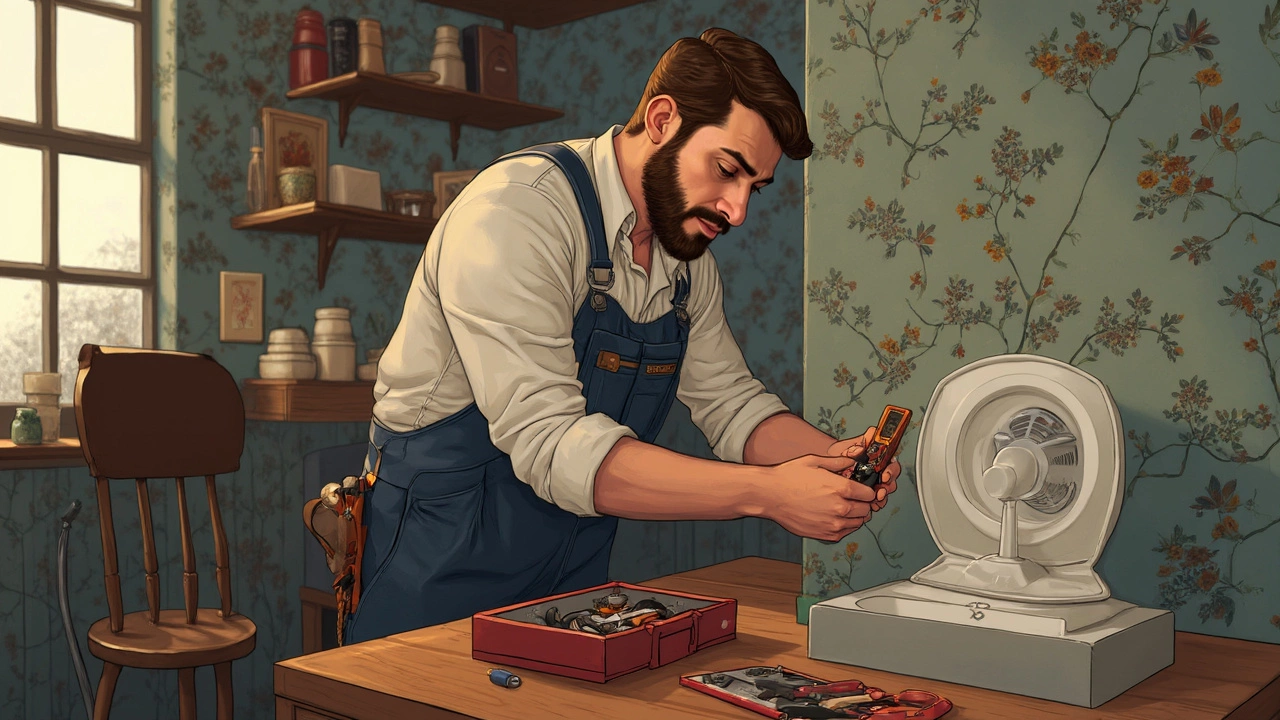Ever had that moment when your extractor fan decides it's done with its job? You're cooking up a storm, and suddenly, no more whirring to pull out the smoke or steam. Annoying, right? But before you panic, there's good news—most issues are fixable on your own.
First things first, let’s get friendly with your extractor fan model. Knowing how it ticks makes everything else easier. Is it wall-mounted, ceiling-mounted, or perhaps part of a cooker hood? Each type comes with its quirks.
Once you’ve nailed down the type, consider common problems like noise, poor suction, or complete silence. Often, the cause isn't as bad as it seems. Start simple: check for obstructions or a disconnected component.
- Understanding Your Extractor Fan
- Common Problems and Quick Fixes
- Tackling Electrical Issues
- Tips for Cleaning and Maintenance
- When to Call a Professional
- Safety Precautions
Understanding Your Extractor Fan
So, you're looking at your extractor fan and wondering what makes it tick. It's more than just a fan stuck to your wall or ceiling; it’s meant to keep your home smelling fresh and free from cooking smoke and steam. Let’s break down how this essential piece of kitchen magic works.
There are two main types: ducted and recirculating. A ducted extractor fan sucks air in and pushes it outside through a vent. Pretty straightforward, but it means there’s some ductwork involved. On the other hand, recirculating fans filter the air and push it back into your kitchen, using special charcoal filters to deal with smoke and odors. These are easy to install since they don’t need outside ducts.
Now, what about the gut of the beast? Each fan has a motor, fan blades, and filters that must be kept in decent shape if you want the fan to keep chugging along. The motor does the heavy lifting, spinning the blades that move air. If you notice funky noises, the motor may need some TLC or replacing.
Let's talk about placement. Do you have a ceiling-mounted fan or is it perched above your stove? This setup impacts how well it draws up all the kitchen smells. The closer it is to the cooking surface, the better it works. If your fan seems sluggish, check this distance!
Here’s a neat table showing you some useful tidbits about fan noise levels and airflow capacity, so you know what to expect from a properly functioning unit:
| Noise Level (dB) | Airflow Capacity (m³/h) |
|---|---|
| 50-60 | 400-600 |
| 61-70 | 601-800 |
By getting to know the specs of your beloved extractor fan, you'll be ready to troubleshoot like a pro. You won’t just listen to its groans; you'll know what they mean and act on them before things spiral out of control.
Common Problems and Quick Fixes
Extractor fans aren't exactly the most complex things, but when they go south, they can be a real headache. Fear not! Here are some common hiccups and how you can tackle them like a pro.
Noisy Fan: If your fan is rattling like it's ready for takeoff, the culprit might be something as simple as debris. Dust and grease can jam the blades. Here's what you do:
- Turn off the power to the fan—safety first!
- Remove the cover. Most covers pop off with a little gentle persuasion.
- Clean the blades and surrounding area using a cloth or brush. Pay special attention to the corners where grime collects.
Fan Not Working: The entire point is for the thing to run, right? If your fan is stubbornly silent, some detective work is needed. Possible causes could include a blown fuse or a wiring issue.
- Check your fuse box to ensure nothing’s tripped. Sometimes, a quick flip of the switch is all it takes.
- Inspect the wiring connections in the fan. Loose connections can prevent power from reaching the motor.
- Finally, make sure the fan switch isn't faulty. You might need to unscrew the switch plate and check for loose wires there, too.
Poor Suction: If steam's hanging around longer than your last awkward date, the motor or ducting might be blocked. Check the ducting for physical obstructions and clean as needed. A strong draft should mean all clear.
Still scratching your head? Extractor fans work best when parts are clean and connected correctly. Regular maintenance can prevent most of these issues from occurring in the first place.
And remember, if you're dealing with electrical issues and feeling out of your depth, best not to risk it alone. Call someone with experience—it’s worth the peace of mind!
Tackling Electrical Issues
Sometimes it feels like your extractor fan is totally unresponsive, and fixing the electrical side of things might seem scary. But don’t worry; with some basic steps, you can sort this out. Let's break it down to make it simple.
First, make sure the fan is actually getting power. It might sound basic, but you'd be surprised how often a tripped circuit breaker is the culprit. Head to your home's electrical box and check if the switch related to your fan is in the right position. If it’s flicked off, just reset it.
Next up, dive into the wiring. Turn off the main power before doing anything—safety first, folks! Remove the cover and inspect the internal wiring. Look for loose connections or burnt wires. If you spot any, it's time to bust out the screwdriver and tighten or replace those sad, frayed bits of wire.
- Check the wire connections: Make sure they’re snug and secure. Loose wires mean no juice.
- Inspect the switch: Pop the switch open and see if the wires attached to it haven’t decided to go AWOL.
- Look at the capacitor: This little guy stores energy for the fan’s motor. A faulty capacitor means your fan won't start, so if yours looks bloated or leaking, it’s time to replace it.
If you’re handy with a multimeter, give the components a quick test. No result? It's either the motor’s gone south or the wiring's crisscrossed.
Dabbling in power repair isn't everyone's cup of tea. If anything feels out of your league, don’t hesitate to reach out to a professional. They have the expertise and tools to diagnose and fix deeper issues that might not be visible at first glance.

Tips for Cleaning and Maintenance
Keeping your extractor fan in tip-top shape isn’t rocket science, but a little TLC goes a long way in preventing bigger issues down the line. Start by unplugging the fan or turning off the power at the breaker to stay safe.
Cleaning the Fan Blades: Test the fan blades with a finger swipe to check for dust. If they’re looking a bit grimy, it’s time for a clean. A mixture of warm water and dish soap usually does the trick. Gently wipe them down with a damp cloth, being careful not to bend anything.
Once the blades are dry, check that they spin smoothly. Occasionally, dust or grease build-up can slow them down, which affects performance.
Washing the Filters: If your fan has filters, they’re probably doing the dirty work trapping grease and dust. Many filters slide out easily for washing. Soak them in warm soapy water and scrub with a brush to remove stubborn grease. A good rinse and thorough drying before reattaching is vital.
Regular Checks: Throw in a quick look at wiring and connections every few months. Loose or damaged wires can mess with the fan’s mojo, so tightening anything that feels loose is a good habit.
- Keep an eye on strange sounds—scraping or buzzing noises spell trouble.
- Lubricate bearings if they’ve stiffened or started squeaking.
- Clean extractor hood grates monthly, especially after major cooking sessions.
Even with diligent care, no fan is invincible. If frequent cleaning doesn’t seem to help or the fan’s consistently losing oomph, it might be time to think about replacement options. Consistency in cleaning and maintenance ensures your extractor fan goes the distance, keeping your kitchen fresh and functioning seamlessly.
When to Call a Professional
Alright, let’s get real. While DIY repairs can save cash and give you some serious bragging rights, not every extractor fan issue is a weekend project. Knowing when to throw in the towel and ring a professional can save you time and maybe even more headaches down the road.
If your fan is still smoking or buzzing despite your best efforts with the toolbox, it might be an electrical problem. Electrical issues shouldn’t be taken lightly. Faulty wiring or a blown motor isn't something you want to tackle solo unless you’ve got electrical chops.
Another red flag is if the fan stops working suddenly after a storm or power outage. This might indicate a bigger electrical system issue in your home, which needs a pro’s eye to ensure everything’s safe and sound.
- If the extractor fan is hard-wired into your home’s electrical system and there are recurring power trips.
- Consistent strange noises even after cleaning and adjusting the fan might signal an internal mechanical fault.
- Visible damage like frayed wires or broken components are best left to those who know their way around such repairs.
And hey, sometimes it’s just about time. If after several attempts the problem persists, a technician can troubleshoot efficiently with the right tools and expertise, often saving you hours of frustration.
Lastly, remember that handling with care is important. Professionals can provide a warranty for their work, which adds an extra layer of safety and assurance that your fan will keep running smoothly for years to come.
Safety Precautions
Before you even think about tinkering with that extractor fan, let's chat about keeping yourself in one piece. Playing it safe is key, especially when dealing with anything electrical or involving potential hazards.
First and foremost, always make sure the power is off. Seriously, it's as easy as flipping the switch on the breaker box to cut power to the fan. Double-check by trying to turn the fan on—if it's not spinning, you're good.
Investing in a good set of insulated tools is a smart move. It reduces the risk of any accidental electrical shocks, which nobody wants to experience. You'll also want some safety goggles, just in case you encounter any flying bits.
Has it been a while since you last cleaned that fan? Then dust and debris might be lurking. Wear a dust mask to avoid sneezing fits or inhaling anything nasty.
When using a ladder or step stool to reach the fan, ensure it's stable and placed on a flat surface. In slippery or narrow kitchen corners, stability is non-negotiable.
- Power off at the breaker.
- Use insulated tools.
- Wear safety goggles and a mask.
- Ensure ladder is stable.
And hey, if you ever get even a whiff of burning smells or other worrying signs, don’t hesitate to cut your DIY adventure short. While most extractor fan repair efforts are pretty straightforward, it's sometimes better to call in a pro. Safety first, always!
| Common Hazards | Precaution |
|---|---|
| Electric Shock | Turn off power, use insulated tools |
| Falling | Ensure ladder stability |
| Inhaling Dust | Wear a dust mask |

